|
|
During ten years surveying small mammal populations in Bolivia’s cerrado, Dr. Louise Emmons with the Smithsonian Institute found that the mammals were suffering precipitous declines, even local extinctions. After ruling out the usual suspects—local fires, rainfall, and flooding—Emmons formed a novel hypothesis regarding the decline. Could a sudden lack of nighttime dew caused by the burning of the Amazon be the cause of the mammal decline?
In the cerrado—a tropical region of grasslands and dry forest—Emmons watched as the Brazilian guinea pig Cavia aperea went locally extinct, and three other rodent species declined significantly: the South American giant rat Kunsia tomentosa, the Paraguayan Bolo mouse Necromys lenguarum, and the Huanchaca mouse Juscelinomys huanchacae. Surveying two different areas in the cerrado, Emmons found a nearly 96 percent decline in small mammals, from a high point of 232 individuals surveyed to a low of ten. In 2004 guinea pigs vanished entirely from the cerrado and have not returned.
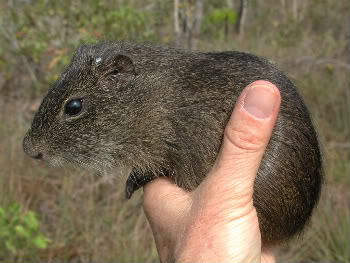 Brazilian guinea pig with eartag just before the disappeared from study site. Photo by: Louise Emmons. |
“Rodents everywhere quite normally undergo big changes in abundance, but numbers usually go up again following declines,” Emmons told Mongabay.com. “In our study, the rodents did not recover their numbers, and an important species, guinea pigs, seemingly went completely extinct. Often rodent abundances change with year-to-year changes in rainfall, but rainfall and other factors such as fire and flooding did not seem able to explain the decline that we saw.”
Another change in the ecosystem, however, caught Emmon’s eye. “When the study began in 1998, we were soaked to the waist from dew on the grass, shoes squelching, each morning when checking savanna traps,” she writes in a paper published in Biotropica. “In later years the morning grass was usually dry.”
The sudden disappearance of nighttime dew coinciding with the rodent declines caused Emmons to wonder if the small mammals had depended either directly or indirectly on the dew. “We do not really know yet whether the small animals and plants need or use dewfall for survival during hot, dry weather, but it is a strong possibility,” she says, describing her theory as an ‘anecdotal hypothesis’ which requires further research.
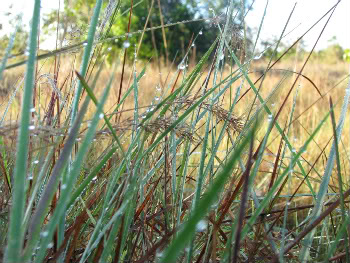 Heavy dew on morning grass. Photo by: Louise Emmons. |
According to Emmons the loss of nighttime dew is caused by the seasonal burning of the Amazon forest in nearby Brazil and biomass burning in Bolivia: “smoke from biomass burning in the dry season was forming a blanket in the sky that was preventing the grassland from cooling down to the dewpoint at night, so that less dew was falling during dry months when no other water is available for the small animals and plants of the savanna.”
Farmers and ranchers burn the Brazilian Amazon annually to make more room for agriculture and ranching. According to satellite data, recent years have seen some of the worst fires in the Amazon. Data collected by a Bolivian airport showed a direct correlation between weather changes in the cerrado and the seasonal burning in both the Brazilian Amazon and the Santa Cruz department of Bolivia.
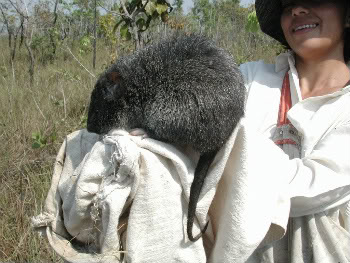 The South American rat is endemic to the cerrado. It suffered significant declines during the survey. Photo by: Louise Emmons. |
“The records from the nearest airport to our study area show that visibility has decreased when deforestation increases in neighboring Brazil. Smoke from burning is what causes decreased visibility,” Emmons explains. “The weather data also shows that the average minimum temperature during the driest month (July) has gradually increased at the same airport. The minimum temperature occurs at night and dew only can form when the temperature is low enough, so an increase in the nightly lowest temperature can prevent dewfall.”
According to Emmons, an in-depth study of the connection between dew and small mammals is needed to determine the validity of her theory. “We really do not know much at all about the role that dew might play in the lives of tiny plants and animals in dry habitats,” she admits. “Two of the mice that declined on our study area eat mainly insects, the other two eat plants. Possibly dew could be important for the insects and plants, and not directly for the mice, but we don’t know. The plants might need dew, then the insects might need to eat those plants, then the mice need to eat those insects, then the maned wolves need to eat those mice . . .You see how it goes. Or the mice might need to drink dew directly during hot, dry weeks – we saw a fox drinking dew by lapping it up from grass, but we have no information about the needs of the little creatures. We need to study the whole cycle of dew formation, smoke, and temperature, and to get down on our hands and knees to study the chains of relationships hidden in the grass.”
A relationship that is currently being studied by one of Emmons’ students is how the disappearance of rodents has already affected one of the area’s largest predators, the long-legged maned wolf. The Brazilian guinea pig is one of the major food sources for the maned wolf in the cerrado. Before their disappearance guinea pigs appeared in 80 percent of maned wolf scats, however after the decline the number of wolf scats including guinea pig dropped to zero. Increasingly, maned wolves, who are omnivorous, are being forced into vegetarianism: in 2007 over half of the wolf’s scats had no meat while four years earlier over 80 percent contained meat.
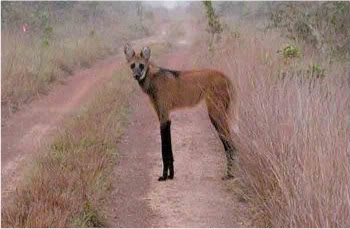 The maned wolf lost prey due to the mysterious disappearance of small mammals in the cerrado. Smoke from seasonal burning can be seen behind the wolf. Photo by: Louise Emmons. |
“The maned wolf seems to have become more frugivorous and are they having a hard time finding animal prey, as not only [guinea pigs], but all savanna rodents seem to have drastically declined,” Emmons says. “Reproduction has not been as successful – but as there could be many other reasons for this we are not sure that it is due to rodent declines.”
If Emmons’ hypothesis turns out to be correct, it would mean a new environmental factor for conservationists to take into account. In addition, the theory may help explain other mysterious mammal declines.
“Australian dry habitats have shown numerous declines and extinctions of small mammals while wetter habitats have not,” Emmons points out. “Although introduced predators (cats, foxes) have likely caused many of the declines, some researchers do not think this can explain those in the Northern Territory, where it has also been shown that patterns of fire have changed, and visibility has decreased because of smoke. I think it is worth taking a second look at what is happening in northern Australia and in other regions with strong dry seasons.”
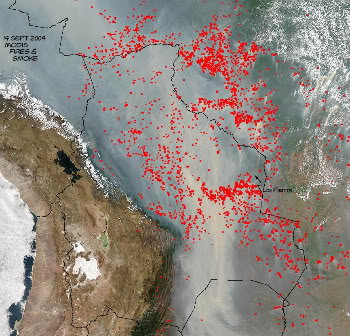 Fires (red points) and smoke on a single day over all of Bolivia (24 August, 2004) study area marked as Los Fierros, photo from NASA – Modis, courtesy of Louise Emmons. |
In the meantime Emmons fears for the cerrado ecosystem in its entirety. Heavily exploited for ranching and industrial agriculture, the ecosystem is one of the most threatened in South America with nearly 70 percent of the ecosystem already lost. Until recently, Emmons notes, the cerrado biome was “overlooked by conservation groups that designate ‘hotspots’ and also by biologists, so its richness in species was not appreciated.”
Pointing to high levels of endemic species, both of plants and animals, Emmons says that the cerrado is millions of years old and includes many undiscovered treasures: “for example, during my work in a tiny area of Noel Kempff Mercado National Park, we have discovered and described four rodent species new to science, and I am sure that we have not yet completely inventoried the mammal fauna.”
CITATION: “Long-Term Variation in Small Mammal Abundance in Forest and Savanna
of Bolivian Cerrado”. Louise H. Emmons. Biotropica, March 9th, 2009.
Related articles
Photos of newly discovered species in Brazil’s Cerrado
(04/29/2008) An expedition to Brazil’s Cerrado has turned up more than a dozen undiscovered species. conservationists say the discoveries add urgency to protecting the grassland habitat which is rapidly being converted for agriculture.
Tree resprouting offers hope in former pastures of Brazil’s cerrado
(09/06/2007) Deforested landscapes in the Brazilian cerrado show hopeful signs of recovery even after long periods of intensive use, reports a study published in the journal Biotropica. Analyzing the natural reestablishment of native trees in former pastureland located in the dry woodlands of the Brazilian cerrado, a team of researchers found that while species richness was lower in older pasture, density and composition of regenerating trees did not change with pasture age.
Biofuels driving destruction of Brazilian cerrado
(08/21/2007) The cerrado, wooded grassland in Brazil that once covered an area half the size of Europe, is fast being transformed into croplands to meet rising demand for soybeans, sugarcane, and cattle. The cerrado is now disappearing more than twice as the rate as the neighboring Amazon rainforest, according to a Brazilian expert on the savanna ecosystem.
Two ‘dragon’ species discovered in Brazil
(01/24/2007) Two previously unknown species of lizard that are said to resemble miniature ground-dwelling dragons have been found in the threatened cerrado region of Brazil. The species, Stenocercus squarrosus and Stenocercus quinarius are described in the current issue of the South American Journal of Herpetology.
Hudson Institute calls Amazon savanna biome a wasteland
(04/23/2006) In an April 21st, 2006 editorial published in the Canada Free Press Dennis T. Avery, senior fellow for Hudson Institute in Washington, DC and the Director for Global Food Issues, called Brazil’s cerrado ecosystem a “wasteland” and criticized a recent report from the environmental activist group Greenpeace that linked Amazon deforestation to soy-based animal feed used by fast-food chains in Europe.
Brazil’s grasslands could replace food production of American heartland
(08/01/2005) Today when people mention Brazil and agriculture, people often first envision the Amazon rainforest giving way to soybean plantations and cattle farms. While the Amazon is being converted for such purposes, the cerrado, a vast area of savanna-like grasslands covering more than 20% of the country’s surface area, is increasingly under threat as farmers from the United States and Europe are setting their sights on the country’s sizeable agricultural potential.